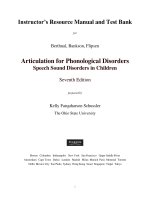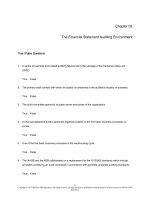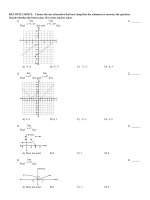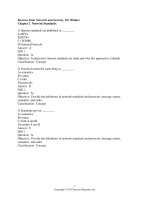Human anatomy and physiology laboratory manual fetal pig version update 10th edition marieb test bank
Bạn đang xem bản rút gọn của tài liệu. Xem và tải ngay bản đầy đủ của tài liệu tại đây (168.28 KB, 4 trang )
MULTIPLE CHOICE. Choose the one alternative that best completes the statement or answers the question.
1) In anatomical position, the ________.
1) _______
A) upper limbs hang in a natural position at the side of the body
B) feet are slightly apart, and the toes point forward
C) head is turned to the side
D) human is sitting
2) Which region is visible only on the posterior/dorsal body surface?
A) patellar
B) mammary
C) buccal
3) The term femoral pertains to the ________.
A) forearm
B) leg
4) Human feet are ________ to the knee.
A) distal
B) proximal
2) _______
D) calcaneal
3) _______
C) arm
D) thigh
4) _______
C) posterior
D) superior
5) The frontal plane divides the body into ________.
A) superior and inferior parts
B) anterior and posterior parts
C) right and left parts
5) _______
6) This organ is found in the thoracic cavity.
A) lung
B) stomach
6) _______
C) small intestine
D) liver
7) This serous membrane lines the walls of the abdominal cavity and covers its organs.
A) pericardium
B) pleura
C) peritoneum
7) _______
8) It is useful to divide this body cavity into quadrants for study because it is so large and contains
so many organs.
A) vertebral
B) cranial
C) abdominopelvic
D) thoracic
8) _______
9) The stomach is found primarily in the ________ quadrant of the abdominopelvic cavity.
A) right upper
B) left lower
C) right lower
D) left upper
9) _______
10) This small body cavity in the head holds the eyes.
A) oral
B) orbital
10) ______
C) nasal
D) middle ear
11) The umbilical region of the human is on the ________ surface, and the umbilical region of the
dog is on the ________ surface.
A) posterior, superior
B) anterior, inferior
C) posterior, inferior
D) anterior, superior
11) ______
12) A patient has a bruise on the ventral surface of the upper limb just distal to the antecubital
region. It is located on the ________.
A) anterior arm
B) posterior arm
C) anterior forearm
D) posterior forearm
12) ______
13) This set of body terms for orientation and direction depends on anatomical position; the terms
have different meanings for humans and four-legged animals.
A) medial/lateral
B) proximal/distal
13) ______
C) dorsal/ventral
D) anterior/posterior
14) In humans, the upper limb is ________ to the lower limb.
A) superficial
B) superior
C) anterior
14) ______
D) proximal
15) If you look at an MRI scan that is oval in shape and you can see the liver, vertebra, and spleen,
this scan was made in the ________ plane.
A) sagittal
B) frontal
C) transverse
15) ______
16) This body cavity is encased in bone.
A) cranial
B) thoracic
16) ______
C) abdominal
17) The spinal cord is found in this body cavity.
A) vertebral
C) thorax
B) cranial
D) thorax and abdominopelvic
18) These two organs are found in the thorax.
A) lungs and stomach
C) liver and stomach
B) heart and liver
D) heart and lungs
D) pelvic
17) ______
18) ______
19) Damage to this serous membrane can cause the lungs to collapse.
A) peritoneum
B) pericardium
19) ______
C) pleura
20) This small body cavity in the head contains the teeth.
A) oral
B) nasal
C) orbital
D) middle ear
20) ______
21) Which of the following is an organ system?
A) lungs
B) urinary
C) heart
D) brain
22) Bones and joints belong to this organ system.
A) skeletal
B) urinary
C) muscular
D) nervous
23) The stomach belongs to this organ system.
A) reproductive
B) respiratory
C) cardiovascular
D) digestive
21) ______
22) ______
23) ______
24) The cardiovascular system ________.
A) cleanses the blood of pathogens and other debris
B) promotes growth and development
C) eliminates nitrogenous wastes from the body
D) transports blood throughout the body
24) ______
25) The integumentary system ________.
A) protects the deep organs from injury and drying out
B) breaks down ingested food
C) is a site for blood-cell formation
D) contributes to the acid-base balance of the blood
25) ______
26) This organ is a large muscular tube that ends at the anus.
A) small intestine
B) esophagus
C) trachea
27) The ________ and ________ are part of the respiratory system.
A) bronchi, thymus
B) testes, ovaries
26) ______
D) large intestine
27) ______
C) lungs, esophagus
D) alveoli, trachea
28) The spleen, thymus, and tonsils are all part of the ________ system.
A) cardiovascular
B) endocrine
C) respiratory
D) lymphatic/immune
28) ______
29) The major organs of the cardiovascular and respiratory systems, the heart and lungs, reside in
the ________ cavity.
A) cranial
B) thoracic
C) abdominopelvic
D) spinal
29) ______
30) The major organs of this system allow you to draw, play tennis, dance, and frown.
A) cardiovascular
B) skeletal
C) nervous
D) muscular
30) ______
1)
2)
3)
4)
5)
6)
7)
8)
9)
10)
11)
12)
13)
14)
15)
16)
17)
18)
19)
20)
21)
22)
23)
24)
25)
26)
27)
28)
29)
30)
B
D
D
A
B
A
C
C
D
B
B
C
D
B
C
A
A
D
C
A
B
A
D
D
A
D
D
D
B
D









